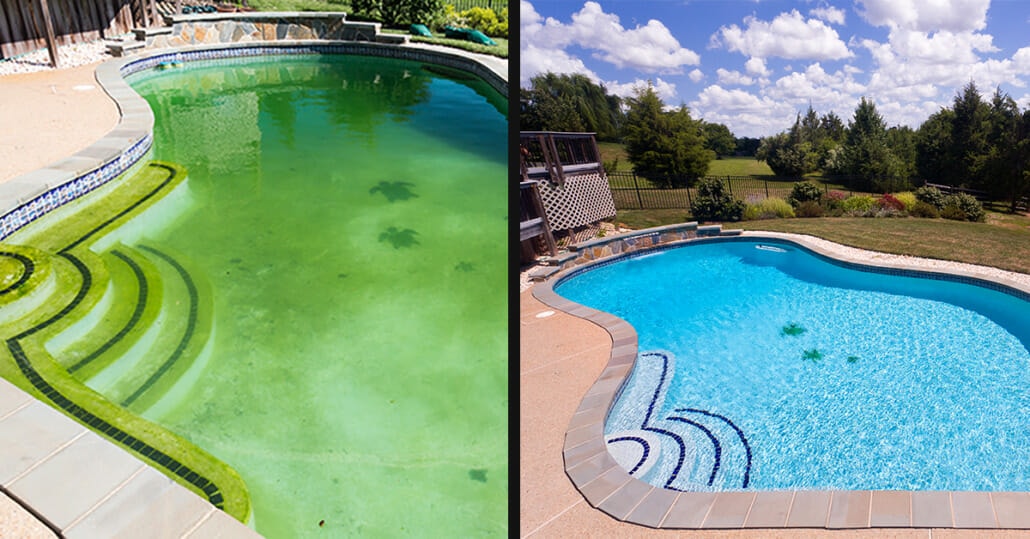SLAM Pool Cleaning: How to Fix Green Pool Water

With pool season in full swing, some are still struggling to clear their pool or have taken a vacation to come home to what used to be a nice clear pool. Whether you’ve been fighting it for a couple of weeks, or it just recently took a turn for the worse, you’ve probably heard about SLAM Pool Cleaning.
Shocking vs. SLAMing
Shocking is the process of adding enough chlorine to reach shock level. It’s good to do if your pool has some algae growing, or if it’s lost its sparkle and is cloudy. SLAMing is for when you find yourself shocking more often than previously or if the pool is in rough shape with lots of algae and you just can’t clear it up.
It requires a larger commitment, both in your time & cost as you’ll use a lot of chlorine. SLAM is an acronym that stands for Shock Level and Maintain. So you’ll need to maintain that shock level of free chlorine for a period of time, such as several days.
Preparing to SLAM your pool
You’ll need a few things handy before you shock your pool. A good test kit like the Taylor K-2006 as it will accurately read the high shock level of chlorine needed to SLAM your pool. You’ll also need quite a lot of liquid chlorine to maintain your free chlorine high enough to complete the SLAM process.
You’ll also want to make sure you will be home and have plenty of free time while you’re SLAMing your pool. More so the first 2 days as we recommend checking your water every 2-3 hours at the beginning. At first you’ll notice the free chlorine drops quickly, but it will drop slower as time goes on and you’re watching the water clear.
Make sure your pump and filter are in good condition with your filter cleaned or back washed as needed. If you’ve been putting off replacing the cartridge, sand or DE grids it should be done before you start. Having good circulation and filtration is important and poor filter health won’t help here.
Make sure you pull any robots out of the water! They’re not meant to be used when SLAMing a pool.
If you have not read the article on CYA and its relation to chlorine, have a read through first and discover what level of free chlorine you need to maintain in order to SLAM your pool.
Have plenty of liquid chlorine on hand! Depending on the size of your pool and the CYA level, you could go through several gallons per day for several days.
Now, on to the steps:
- Correct your pH. This needs to be balanced close to 7.2. If you’ve been following our blog you’re aware of the importance pH plays in pool chemistry. Make sure you don’t go by the pool store’s recommendation as it won’t be low enough. The stores will calculate acid demand to the upper end of the recommended range. If the pool store’s pH range says 7.2-7.6, the amount of acid needed will bring you to 7.6pH
- CYA or stabilizer level needs to be corrected. If it’s too low, chlorine won’t be effective in the sun. Too high and your chlorine is less effective. When SLAMing your pool, higher is better than low since you need to maintain shock level over a period of days, but you’ll need a higher free chlorine level to compensate.
- Add your chlorine. As a rule of thumb 1 gallon of 10% liquid chlorine will increase the free chlorine by 10ppm. Always lean on the side of caution and round up. Chlorine does get weaker over time as well.
- Time to brush your pool, by hand. Remember, no robots during this process as the high amount of chlorine bleach will damage it.
- Check the free chlorine and add more if it’s already come down. Remember, you want to maintain the shock level of chlorine until the water is clear. If it gets too low, you’re only hurting your wallet. For the first couple days, repeat this every few hours. Depending on how bad your pool was, it will get to a point where it doesn’t drop as fast and you’re almost done.

Lots of chlorine to SLAM your green pool!
How to know you’re done:
Is the water clear yet? Once it looks good you’ll do the following to make sure:
- You’ll want to test chlorine loss overnight, meaning comparing free chlorine after sunset to right before. You should see less than 1ppm of free chlorine drop. Test after sunset & before sunrise.
- Your combined chlorine should be under 0.5, or as close to 0 as possible.
How to prevent having to SLAM your pool again:
If your pool is chlorine or salt generated chlorine, make sure you’re maintaining the chlorine level continuously. Have a read through here as to why pH is so important on a salt pool. If your chlorine couldn’t keep up, it was probably due to too high of pH. We know your pool builder or pool store told you that adding salt would solve all your problems, but it’s only the sanitation side of pool chemistry. Keep that chlorine at the right level based on your CYA or stabilizer level.
Consider adding an ionizer to your pool. MineralPure® ionized pools are less likely to need to be SLAM’d as the copper prevents algae from growing and doesn’t disappear like chlorine.
If your pool is a MineralPure® pool, make sure you keep chlorine in the water until your ion level is back in range. Once it reaches 0.15-0.2ppm, you can stop adding chlorine. Keep your pH in balance as well, though that’s much easier without chlorine causing pH changes.
If you have questions, email us: SLAM@clearwaterenviro.com








